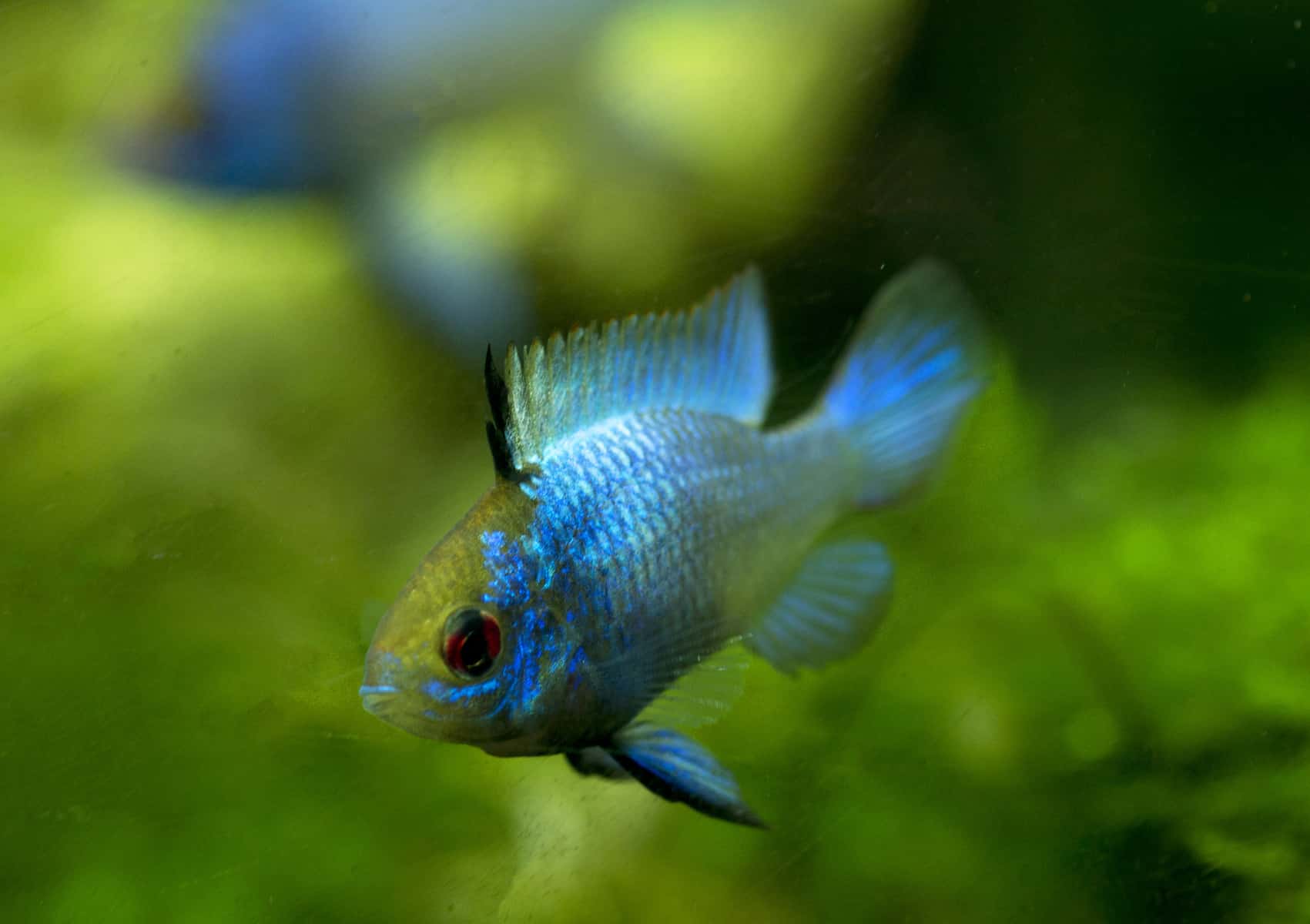The Electric Blue Acara is an absolutely stunning freshwater fish that makes a great centerpiece for any tropical aquarium setup.
The good news is that these fish are not only beautiful to look at, but they are also relatively easy to care for too. Although these fish are cichlids, they don’t have the aggressive temperament of some of their relatives, and they can be a member of a peaceful community, provided that you pick the right tankmates.
So, is the Blue Acara the right choice for your tank?
In this comprehensive guide, we give you all the information that you need to care for these breathtakingly gorgeous fish, and more.
Origins and habitat
The Electric Blue Acara is also called Aequidens pulcher, Cychlasoma pulchrum, and Andinoacara pulcher. Sometimes the species is just called the Blue Acara.
The species is native to Trinidad & Tobago, Colombia, and Venezuela. The Blue Acara has also been introduced to Indonesia and Australia. The fish is very adaptable to its surroundings and can live in turbid, standing water as well as in crystal clear, free-flowing rivers and streams.
In the wild environment, the Blue Acara can live for 20 years. If well cared for, these fish usually have a lifespan of eight to ten years in captivity.
Appearance
When it comes to appearance, the Electric Blue Acara’s name is a giveaway!
These fish are an incredible brilliant metallic blue. The blue is a light shade that fades toward yellow on the front part of the fish’s body, while the top edges of the dorsal fin are a vibrant orange/yellow. The brightness of the blue coloration highlights every scale on the fish’s body, giving a definition that’s absolutely eye-catching. The color fades toward the fish’s forehead into a dark gray that covers the head.
The fish has the typical cichlid shape with a dorsal fin that begins roughly a quarter of the way back from the head and extends right down the fish’s back to the caudal fin, which is symmetrical in shape.
At maturity, the Blue Acara cichlid can measure between six to seven inches in length.
Mistaken identity?
When you set out to the fish store to buy an Electric Blue Acara, be careful that you buy the correct species of cichlid!
Another cichlid that can look very similar to the Electric Blue Acara is the juvenile form of the Green Terror cichlid. When grown, Green Terrors will grow much larger and will be extremely aggressive toward other members of your community.
Care and maintenance
The Electric Blue Acara is a relatively easy fish to care for, making these beautiful cichlids a good choice for both novice and experienced aquarists.
That said, you do still need to know the fish’s preferred diet and tank conditions so that you can provide the care your new fish needs if he is going to thrive.
Tank size
The smallest tank size that’s suitable for Blue Acaras is 30 gallons, and the aquarium should be at least 4 feet long. That provides plenty of swimming space for these active fish. However, if you can provide a bigger tank, so much the better.
Also, if you’re intending on keeping a group of these fish, you should allow an additional 15 gallons per fish. Therefore, to keep a pair of Blue Acaras, you will need a tank of at least 45 gallons.
Tank environment
As with any species, the Electric Blue Acara is happiest when housed in an environment that mimics its natural habitat.
So, the tank should contain plenty of places where the fish can rest and feel secure, including tangles of driftwood. That’s crucial for keeping the fishes’ stress levels down, which helps to prevent outbreaks of disease. Like many cichlids, the Acara is a renowned digger. For that reason, you’ll need to use a soft, sandy substrate so that the fish don’t injure themselves.
Live planting is also recommended, but floating plants are best. Not only does floating vegetation replicate what’s often found in the fish’s natural environment, but it also prevents the plants from being dug up by the fish and helps to diffuse the lighting.
That said, some hardy plant species such as Microsorum and Anubias can be grown on bogwood or driftwood, which removes the problem of the plants being dug up by the fish and adds further interest to the environment for the onlooker and for the fish.
Water parameters
The Electric Blue Acara is a fairly hardy fish that can tolerate a wide variance in conditions. That said, it’s still essential that you maintain the water quality in the tank. Poor water quality can result in the fish’s immune system becoming weakened, leaving it vulnerable to diseases.
The water temperature in the tank should be between 72° to 82° Fahrenheit, ideally as close to 76° Fahrenheit as possible. Water pH levels should be in the range of 6.0 to 7.5, with 7 to 7.5 being optimal. Water hardness should be 6 to 20 dH.
You will need a very efficient filtration system that can cope with the quantity of waste these fish produce and the vigorous substrate digging that goes on.
Diet and nutrition
Providing your Electric Blue Acara with the correct diet is extremely important for his wellbeing, and feeding a diet that mimics what the fish would eat in nature is best.
The Blue Acara is an omnivore, although the main part of the fish’s diet is meat-based. So, your fish will need a high-protein diet to satisfy his nutritional requirements. You can include live and frozen bloodworms, daphnia, mosquito larvae, and brine shrimp in the mix.
The fish will also take flakes and pellets but do check the ingredients to make sure that the food contains plenty of meat-sourced protein, and avoid any products that have large amounts of cereal meal and other padding ingredients. Padding contains no nutritional value and too much of it is bad for the fish’s digestive system.
Flakes and pellets usually contain a vegetable element too, which is extremely important, as it helps to provide your Electric Blue Acara with a correctly balanced diet.
How much food?
Overfeeding your fish is bad for them and can damage the water quality in your tank too. Uneaten food finishes up getting lost in the substrate, where it gradually decomposes, adding to the ammonia and nitrate burden that your filtration system has to process.
To avoid giving your fish too much to eat, feed them two or three times per day, offering just as much food as the fish will clear up in a couple of minutes.
Electric Blue Acara Temperament
Unlike Oscars, Jack Dempseys, Jewel cichlids, and African cichlids, the Blue Acara is a peaceful, non-aggressive fish. That’s great news if you want to add an Electric Blue Acara to a community tank.
These are entertaining fish to watch. They’re curious and love to spend time exploring their environment, digging around in the substrate for tidbits to nibble on. But the Blue Acara can be shy too, hiding away in caves or amongst thick planting, only peeking out occasionally to check out passing tankmates.
Tankmates
The Electric Blue Acara is a peaceful fish that gets along well with most other species in a community tank, and that can make it quite straightforward to choose suitable tankmates for your blue beauty.
Fish species that you should avoid mixing with the Electric Blue Acara include anything that is much larger than the Blue Acara, or that is known to be exceptionally aggressive. Conversely, very small fish can be hassled by the Blue Acara cichlid, so it’s recommended that you choose peaceful species of a similar size to the Acara.
A few species that make good tankmates for the Electric Blue Acara include:
So, essentially, any peaceful species of a similar size that shares the same water parameter requirements to the Electric Blue Acara should make a suitable tankmate.
If you want a species-only tank, a small group of Electric Blue Acaras makes a stunning display. Ideally, you want to have a group that’s divisible by two. So, you could have six, eight, or even ten fish in a school, and all should be well.

Breeding
The Electric Blue Acara is quite easy to breed in the home aquarium. If you want to breed your fish, you’ll need to know how to differentiate the sexes. Mature male Electric Blue Acaras usually have slightly elongated dorsal and anal finnage while females are heavier-bodied.
The fish are generally ready to breed once they reach four or five inches in length. This is a monogamous cichlid, so once the spawning process has finished, you won’t be able to swap and change the partners around. If you want to encourage the breeding process and remove the danger of the adult fish eating the fry, it’s recommended that you set aside a dedicated breeding tank.
Ideally, you need a 20-gallon aquarium that’s set up with plenty of live planting and hiding places. Make sure that the substrate you use is soft, as the male and female will be very active around the tank bottom throughout the mating process. You should also provide some flat rocks on which the fish will lay their eggs.
Set the water temperature to around 75o Fahrenheit, and keep the water hardness and other parameters the same as they are in the main aquarium.
Spawning
When spawning begins in earnest, the fish will stick together for much of the time. Both partners will clean an area at the bottom of the tank, usually on a suitable rock where they will eventually lay their eggs. The female fish lays her eggs on the rock, and the male fertilizes them afterward.
Once spawning is over, both parents will guard the eggs until they hatch, which usually takes place a few days after fertilization.
While spawning is taking place, the Electric Blue Acara can become more aggressive than usual. That’s why it’s safest to move the breeding pair to a separate tank.
Diseases
A healthy fish will be resistant to most of the common fish diseases. That said, Blue Acaras can suffer from Ich and skin flukes.
Ich
Ich is a very common condition in freshwater and marine fish species. In freshwater fish, Ich is caused by the free-swimming protozoan parasite, Ichthyophthirius multifiliis.
Ich is often present in healthy fish tanks but only attacks weak or sick fish. Fish with Ich often flick or rub against the substrate or objects in the tank in an attempt to relieve the irritation caused by the parasite.
You may also notice that affected fish have clamped fins, breathing problems, and general lethargy. But the most obvious symptom of an Ich infection is a rash of tiny white spots that appears on the fish’s body, fins, and gills, giving the illness its common name, White Spot Disease.
The Ich parasite has a complicated lifecycle. For that reason, it’s best to treat outbreaks in the tank itself, rather than by removing individual fish. Elevating the water temperature to 82o Fahrenheit may help to disrupt the parasite’s lifecycle while treating the water with an over-the-counter medication will help to kill it.
Availability
The Electric Blue Acara is readily available from good fish stores and online.
You can buy a small specimen for upward of $10. The larger the fish, the higher the price. Remember, if you buy from an online supplier, you will also have to pay shipping costs, and you don’t get to see the specimen you’re buying until it arrives.
So, if possible, we recommend that you always buy your fish from a store where you can choose the specimen yourself.
FAQ
In this section of our guide, we answer a few of the questions that are most often asked by people who are thinking of adding one of these beautiful fishes to their collection.
Q: How big do Electric Blue Acaras get?
A: These cichlids grow to six or seven inches in length in captivity.
Q: What fish can live with Blue Acara?
A: Ideal tankmates for the Electric Blue Acara include any peaceful species that are around the same size as the Acara. Avoid very tiny fish that could be hassled and very large, aggressive species.
Q: Are Electric Blue cichlids aggressive?
A: The Electric Blue Acara is typically a peaceful character. However, both sexes can become aggressive during spawning, which is why it’s best practice to remove them to a separate breeding aquarium.
Q: How can you tell if an Electric Blue Acara is male or female?
A: If you want to breed your fish, you’ll need to know how to differentiate the sexes. Mature male Electric Blue Acaras usually have slightly elongated dorsal and anal finnage while females are heavier-bodied.
Final thoughts
The Electric Blue Acara is a peaceful cichlid that grows to a manageable size, making this species a great choice for a community or species-specific aquarium. And, most notably, these shimmering bright blue fish are simply stunning to look at!
The Blue Acara tolerates a wide range of water conditions and may be kept safely with their own species and with other peaceful fish of the same size. You can breed the Electric Blue Acara quite easily in a separate breeding tank, which can make a fun and interesting project for the more experienced hobbyist.


























